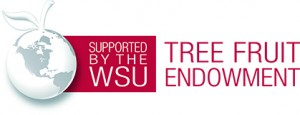Written by Liesl Oeller, Washington State University, July 3, 2025
As temperatures rise in much of Washington and Oregon, apple sunburn risk increases. Check the DAS sunburn model for apples to assess risk in your area this summer.

There are different types of sunburn in apples: sunburn browning, photooxidative sunburn, and sunburn necrosis.

Sunburn browning is the most prevalent type of sunburn, and it is caused by high fruit surface temperatures and ultraviolet radiation. Sunburn browning usually occurs during the afternoon on fruits acclimated to high light (i.e. previously exposed to sunlight for several days before the sunburn event). However, sunburn browning symptoms may not appear for a few days after the sunburn event occurs. Internal fruit quality of apples with sunburn browning is affected and declines further during cold storage. This is another reason to protect your apples from sunburn.
Photooxidative sunburn occurs in apples that have been shaded prior to sudden exposure to full sun (e.g. apples exposed during thinning or pruning, or when a limb shifts with heavy crop load). This sunburn type is independent of temperature, and is caused by visible light. The first symptom of photooxidative sunburn is whitening of the sun-exposed side. Later necrosis may form on these apples in the center of the bleached area.
Sunburn necrosis results from thermal death that occurs at a fruit surface temperature of ~126 °F. If no protective practices are used, Washington State apple growers lose about 10%, on average, of their crop to sunburn cullage.
Read the full article about different types of apple sunburn on the DAS website!
Now is the perfect time to subscribe to DAS! Keep track of pest emergence and see management options as the season progresses. You can use our time machine tool to look back on weather data from the last 5 years, and see how 2025 compares. You can also set up alerts to remind you when key pests are emerging for timely management.
For weekly updates on DAS models and tools, subscribe to our mailing list. Now is the perfect time to subscribe to weather stations on DAS, get started today!
Contact
Liesl Oeller
Washington State University
elisabeth.oeller@wsu.edu
(509) 335-5815
Fruit Matters articles may only be republished with prior author permission © Washington State University. Reprint articles with permission must include: Originally published by Washington State Tree Fruit Extension Fruit Matters at treefruit.wsu.edu and a link to the original article.

